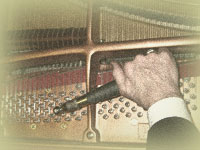 I grew up with a piano - it was always a part of my life. Before I was even born, my family had the piano. It was first owned by my grandfather's brother, my great uncle Dick. Eventually it found its way to my parents' home, where my sisters learned how to play on it. Then one day I wandered up to the tall bench, looking up to the even taller upright, its oak wood golden, and its brass foot peddles heavy and mysterious. I crawled up and pressed the white and black keys, and was delighted by the sounds they made. My older sister showed me how to play a song with her, a silly song, but fun, and I laughed with her. She told me it was called 'Chopsticks'. I had learned my first song...
I grew up with a piano - it was always a part of my life. Before I was even born, my family had the piano. It was first owned by my grandfather's brother, my great uncle Dick. Eventually it found its way to my parents' home, where my sisters learned how to play on it. Then one day I wandered up to the tall bench, looking up to the even taller upright, its oak wood golden, and its brass foot peddles heavy and mysterious. I crawled up and pressed the white and black keys, and was delighted by the sounds they made. My older sister showed me how to play a song with her, a silly song, but fun, and I laughed with her. She told me it was called 'Chopsticks'. I had learned my first song...When I was in second grade, my mother found a piano teacher in Emerson, Mrs. Forrest. She was very strict, teaching from the Royal Conservatory of Music (Toronto) style. She stressed proper body posture - how I sat, how I held my arms, wrists, and hands - and never ever let me forget to keep those hands up. An arched hand was a happy hand; a lazy hand got a ruler. "Never look at the keys," she would drill into me.
 I found out that for every song you played well, not only were hours practiced on that composition, but many more hours were spent dedicating yourself to the mechanics that underlay each piece of music: The Notes! Hours were spent learning each key white and black, each octave, how keys connect; scales, arpeggios, the Latin terminology, reading music, learning the history of the great composers.
I found out that for every song you played well, not only were hours practiced on that composition, but many more hours were spent dedicating yourself to the mechanics that underlay each piece of music: The Notes! Hours were spent learning each key white and black, each octave, how keys connect; scales, arpeggios, the Latin terminology, reading music, learning the history of the great composers.While I initially lived a little in fear of Mrs. Forrest, I learned to respect her, and eventually realized she gave me an incredible grounding in the basics that I benefited from throughout the rest of my training.
 Back to the piano.
Back to the piano.The piano was a Bush & Gerts*, one of their tall uprights. I didn't notice that right away. To me, it was just a piano. But as I learned how to play, I began taking a pride in the piano I was playing on. For instance, the piano case was made out of the most beautifully-grained oak. The white keys themselves had a swirling translucence that I learned was for a very good reason - they were made from real ivory, something that is illegal nowadays (for good reason...) It became one of my chores to dust and polish the piano, and I always made sure it was done impeccably.
I took a peek under the top door one day...it was like another world. I pressed keys and watched the action - the hammers, the dampers, the frame itself with all the strings. It was also then that I noticed a fascinating label, in gold, that talked about the famous Exhibition in Chicago many years ago, and how this piano was made by a company that won awards there.
 It was then, when looking even deeper inside, that I discovered handwriting near the top of the soundboard, above the strings. It was like a time capsule, dates and names of tuners over the years all the way back to shortly after my uncle bought it, all written in pencil.
It was then, when looking even deeper inside, that I discovered handwriting near the top of the soundboard, above the strings. It was like a time capsule, dates and names of tuners over the years all the way back to shortly after my uncle bought it, all written in pencil. * - Bush & Gerts pianos were manufactured in one of the largest and most thoroughly equipped factories in the world. The company controlling Bush & Gerts was one of the strongest in the piano industry and the aim was to sustain the distinction which the instruments have gained in the long and persistent reaching out for perfection in tone production. In the ware rooms of the foremost piano merchants of the world Bush & Gerts pianos were presented as instruments worthy of the highest and most discriminating trade. The Bush & Gerts factory was located at Rockford, Ill.
Just lovely, Trish. I had no idea how much went into learning piano. My mom had lessons from a nun who would "rap" her knuckles with a ruler. You two could commiserate!
ReplyDeleteI've always wanted to learn. Never had easy access to a piano. I'll leave it to my Bucket List...
~K